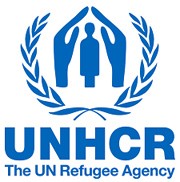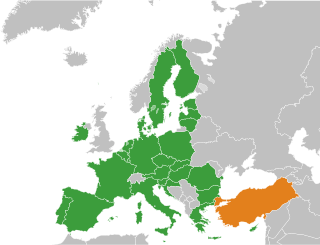Related Research Articles
Since 1945, immigration to the United Kingdom under British nationality law has been significant, in particular from the Republic of Ireland and from the former British Empire, especially India, Bangladesh, Pakistan, the Caribbean, South Africa, Nigeria, Ghana, Kenya, and Hong Kong. Since 1992-1993, when the EU was created, immigrants have come from member states of the European Union, exercising one of the European Union's Four Freedoms. In 2021, since the Brexit came into effect, previous EU citizenship's right to move and reside in the EU on a permanent basis does not apply anymore. A smaller number have come as asylum seekers seeking protection as refugees under the United Nations 1951 Refugee Convention.

The Dublin Regulation is a European Union (EU) law that determines which EU Member State is responsible for the examination of an application for asylum, submitted by persons seeking international protection under the Geneva Convention and the EU Qualification Directive, within the European Union. It is the cornerstone of the Dublin System, which consists of the Dublin Regulation and the EURODAC Regulation, which establishes a Europe-wide fingerprinting database for unauthorised entrants to the EU. The Dublin Regulation aims to "determine rapidly the Member State responsible [for an asylum claim]" and provides for the transfer of an asylum seeker to that Member State.
Immigration to Germany, both in the country's modern borders and the many political entities that preceded it, has occurred throughout the country's history. Today, Germany is one of the most popular destinations for immigrants in the world, with well over 1 million people moving there each year since 2013. As of 2019, around 13.7 million people living in Germany, or about 17% of the population, are first-generation immigrants.

The European Border and Coast Guard Agency, also known as Frontex, is an agency of the European Union headquartered in Warsaw, Poland, tasked with border control of the European Schengen Area, in coordination with the border and coast guards of Schengen Area member states.
An unaccompanied minor is a child without the presence of a legal guardian.
Asylum shopping is the practice by asylum seekers of applying for asylum in several states or seeking to apply in a particular state after transiting other states. The phrase is used mostly in the context of the European Union and the Schengen Area, but has also been used by the Federal Court of Canada.

The United Nations High Commissioner for Refugees Representation in Cyprus is an office of the United Nations High Commissioner for Refugees (UNHCR) opened in August 1974 upon the request of the Government of Cyprus and the Secretary-General of the United Nations. UNHCR Representation in Cyprus was designated as Coordinator of the United Nations Humanitarian Assistance for Cyprus. UNHCR was also responsible upon the request of the Cyprus Government to examine applications for refugee status.
The Gateway Protection Programme was a refugee resettlement scheme operated by the Government of the United Kingdom in partnership with the United Nations High Commissioner for Refugees (UNHCR) and co-funded by the European Union (EU), offering a legal route for a quota of UNHCR-identified refugees to be resettled in the UK. Following a proposal by the British Home Secretary, David Blunkett, in October 2001, the legal basis was established by the Nationality, Immigration and Asylum Act 2002 and the programme itself launched in March 2004. The programme enjoyed broad support from the UK's main political parties.
The Unit of Rehabilitation of Victims of Torture (URVT) has operated in Cyprus since 2005.

Asylum in the European Union (EU) has its roots in the 1951 Convention Relating to the Status of Refugees, an agreement founded on Article 14 of the Universal Declaration of Human Rights. Following the adoption of the Schengen Agreement on the elimination of internal border controls of signatory states and its subsequent incorporation into the EU legislative framework by the Amsterdam Treaty, the EU set up a Common European Asylum System (CEAS) to unify minimum standards related to asylum, leaving up to EU Member States the discretion to establish procedures for obtaining and withdrawing international protection.
Refugees of the Syrian Civil War are citizens and permanent residents of Syria who have fled the country over the course of the Syrian Civil War. The pre-war population of the Syrian Arab Republic was estimated at 22 million (2017), including permanent residents. Of that number, the United Nations (UN) identified 13.5 million (2016) as displaced persons, requiring humanitarian assistance. Of these, since the start of the Syrian Civil War in 2011 more than six million (2016) were internally displaced, and around five million (2016) had crossed into other countries, seeking asylum or placed in Syrian refugee camps worldwide.

The European Asylum Support Office (EASO) is an agency created by European Union Regulation 439/2010 to increase the cooperation of EU member states on asylum, improve the implementation of the Common European Asylum System, and support member states under pressure.

The 2015 European migrant crisis was a period of significantly increased movement of refugees and migrants into Europe in 2015, when 1.3 million people came to the continent to request asylum, the most in a single year since World War II. Those requesting asylum in Europe in 2015 were mostly Syrians, but also included significant numbers of Afghans, Nigerians, Pakistanis, Iraqis and Eritreans.

The European Commission's Asylum, Migration and Integration Fund is a funding programme managed by the Directorate-General for Migration and Home Affairs which promotes the efficient management of migration flows and the implementation, strengthening and development of a common approach to asylum and immigration in the European Union. All EU Member States except Denmark participate in the implementation of this Fund. Most of the funds are provided to the EU Member States for activities addressing previously agreed upon themes. A part of the funding is reserved for emergency assistance. A final part is reserved for Union Actions, which are European Commission managed projects that are developed as either calls for proposals, direct awards, procurements, or delegation agreements.

Relations between the European Union (EU) and Turkey were established in 1959, and the institutional framework was formalized with the 1963 Ankara Agreement. Albeit not officially part of the European Union, Turkey is one of the EU's main partners and both are members of the European Union–Turkey Customs Union. Turkey borders two EU member states: Bulgaria and Greece.
Humanitarian visas are visas granted by some countries in order to fulfill their international obligation to protect refugees from persecution. The criteria in the Convention Relating to the Status of Refugees are often used in assessing whether or not there is a legitimate claim for protection. It defines a refugee as a person who:
"Refugees as weapons", or "Weapon of Mass Migration" is a term used to describe a hostile government organizing, or threatening to organize, a sudden influx of refugees into another country with the intent of overwhelming its borders or causing political discomfort.It often exploits the targeted country's humanitarian obligations to take in refugees and hear their asylum claims. The responsible country usually seeks to extract concessions from the targeted country and achieve some political, military, and/or economic objective.
Turkey's migrant crisis, sometimes referred to as Turkey's refugee crisis was a period during the 2010s characterized by high numbers of people arriving in Turkey. Turkey received the highest number of registered refugees of any country or territory every year from 2014 to 2019, and had the world's largest refugee population according to the United Nations High Commissioner for Refugees (UNHCR). The majority are refugees of the Syrian Civil War, numbering 3,591,892 as of June 2020. In 2018 the UNHCR reported that Turkey hosted 63.4% of all the "registered Syrian refugees."
Migration policy of the European Union - is a set of principles and measures used by member countries of the European Union aimed to regulate migration processes in the EU zone.
References
- ↑ "European Refugee Fund". UNHCR. Retrieved 21 July 2015.
- 1 2 "Refugee Fund". European Commission. Retrieved 21 July 2015.
- ↑ Peers, Steve (2011). EU Justice and Home Affairs Law (3rd ed.). Oxford: Oxford University Press. p. 124. ISBN 978-0199604906.
- ↑ "ECRE publishes note on the Asylum, Migration and Integration Fund". European Council on Refugees and Exiles. 29 May 2015. Archived from the original on 6 September 2015. Retrieved 21 July 2015.